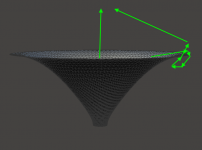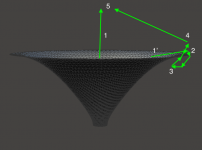This has nothing to do with a room - this all happens in free field (with only the waveguide present) and it is clearly visible in all the simulated data.
Simply, after the sound radiated at the throat diffracts around the mouth edge, it can and will return back again, no matter there's no wall behind...and we want to minimize this.
Simply, after the sound radiated at the throat diffracts around the mouth edge, it can and will return back again, no matter there's no wall behind...and we want to minimize this.
Last edited:
How can you have a wave entering towards a WG from behind, like your simulation, in a complete free field?
//
//
The sound obviously diffracts or reflects at the back side, it may even go around. Not in a large quantity but still.
Last edited:
Diffraction emanating from a wave launched in the natural forward way out of a WG would never hit the backside in the same way as if an exciter was firing at it from behind - I doubt that.
//
//
Last edited:
The "exciter" was there only for the purpose of this simple experiment - in the principle it will be similar. Maybe someone could come up with a better approach.
Obviously there are shapes more and less effective in preventing the sound from returning in the frontal direction (towards the listener). My aim would be to investigate this. And the half-rollback seems to be pretty good in this regard.
If you whant to understand how a naturally excited wave behave behind the WG, depending on roll-back-length, just extend the hor/vert analysis to 180 deg? Then you will see whats going on "behind" the WG - no? But to hear this, the listener must be behind the WG - in the same way as in a free filed situation, one must be 60 deg on the side to hear what the "hor 60 deg FR" sound like.
Anything coming from behind must be a reflection I suppose!? Sound dont do 180 deg turns by themselves.
//
Anything coming from behind must be a reflection I suppose!? Sound dont do 180 deg turns by themselves.
//
In a free field environment, the only thing you will hear is the direct sound 0/0 deg if you sit exactly right in front of the WG. What the h5/v5 deg FR curve (and all the other 17+17) look like is unimportant as one wont hear them... in this unrealistic situation that will never appear 😉
//
//
I do the 180 deg (i.e. full sphere) analysis all the time, but no, I don't want to know how the waves behave behind the waveguide. I want to know how strongly they pass around the mouth edge again towards the listener. They really do pass, that's diffraction.If you whant to understand how a naturally excited wave behave behind the WG, depending on roll-back-length, just extend the hor/vert analysis to 180 deg? Then you will see whats going on "behind" the WG - no?
//
Last edited:
So #5257 was not totally correct - it lacks the small contribution from actual diffraction coming from the front going backwards - this diffraction will have to bounce on the back wall in order to be an incoming wave from behind, towards the WG.
//
//
Last edited:
As usual, I miss something :-/
Could you please describe the course of events?
If what you say is true, then the simulations you do is not "correct" - the FRs for 0deg/0deg you show lack something! This diffraction contribution?
So its a diffraction on the curved edge of the rollback (say h45) that when it "diffracts", radiates in all directions including the 0deg/0deg and thus, contributes to the on axis FR?
//
Could you please describe the course of events?
If what you say is true, then the simulations you do is not "correct" - the FRs for 0deg/0deg you show lack something! This diffraction contribution?
So its a diffraction on the curved edge of the rollback (say h45) that when it "diffracts", radiates in all directions including the 0deg/0deg and thus, contributes to the on axis FR?
//
Last edited:
You just can't prevent the sound from diffracting and reflecting and this happens all around the waveguide. At the rear, whatever is directed towards the mouth edge, it will diffract again, this time towards the listener (and perhaps inside the waveguide). These are small effects but we have already so good waveguides that we can see even these small changes.
TNT what mabat is showing is how well the termination works in guiding waves from both directions.
With the 180 termination when sound comes from behind less of it makes it's way to the front because of the termination, just the same as when viewing the termination from the front less sound wraps around the back.
With the 180 termination when sound comes from behind less of it makes it's way to the front because of the termination, just the same as when viewing the termination from the front less sound wraps around the back.
Well maybe this explanation is completely wrong, that's also perfectly possible - it's only my best effort to understand what's going on.
Please, take the side profile of your big sand horn and with straight lines with arrows, draw the path of the event you envision. I'd really like to understand this and such a picture would help me.
//
//
Attachments
Last edited:
- Home
- Loudspeakers
- Multi-Way
- Acoustic Horn Design – The Easy Way (Ath4)

